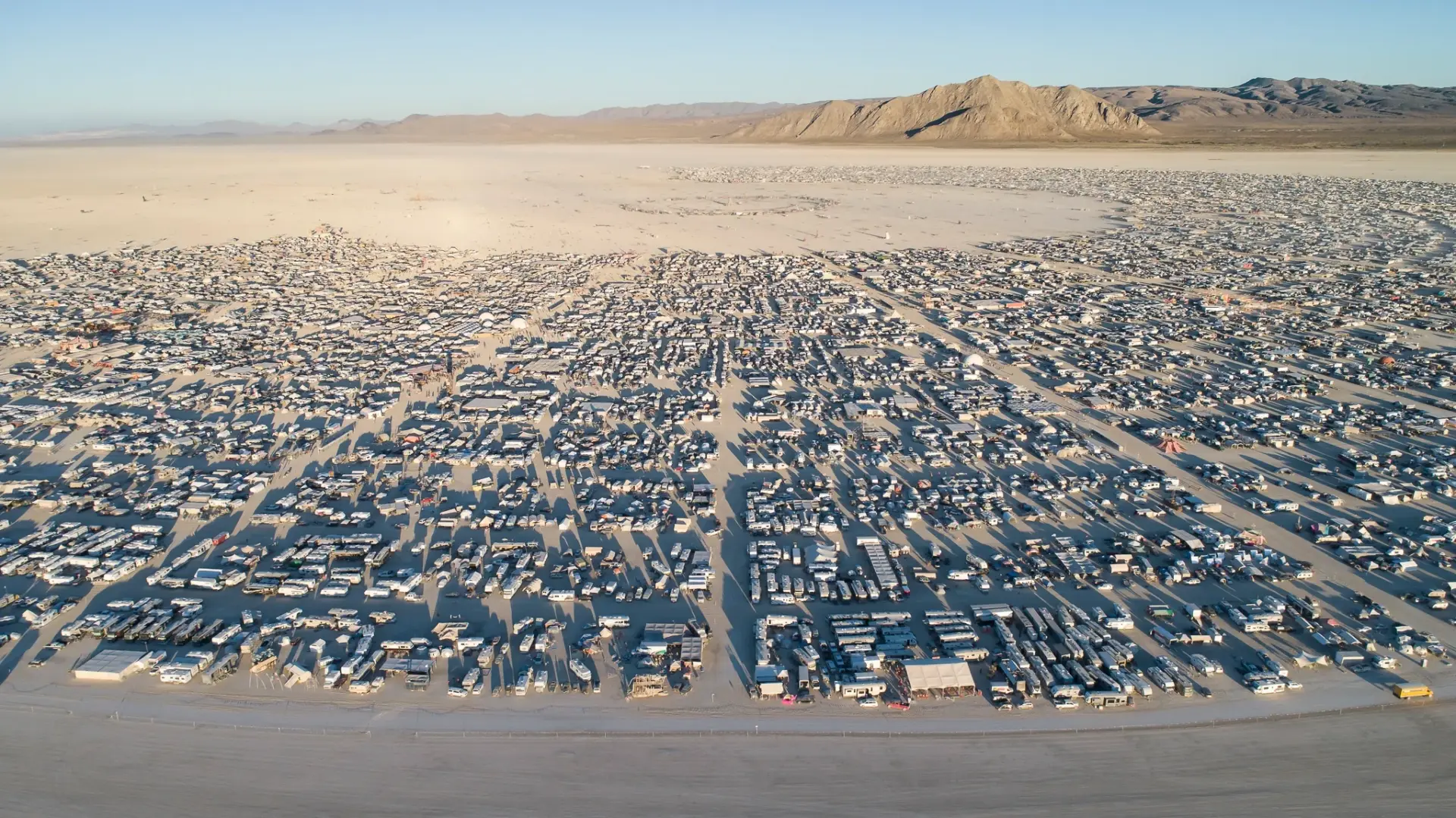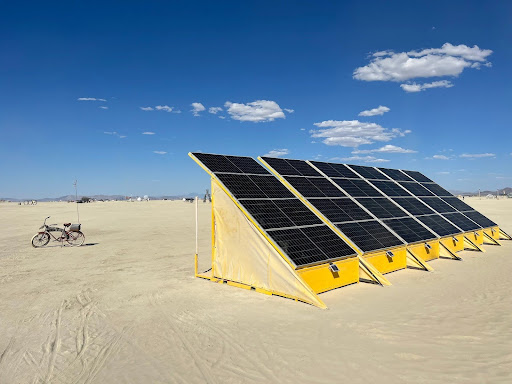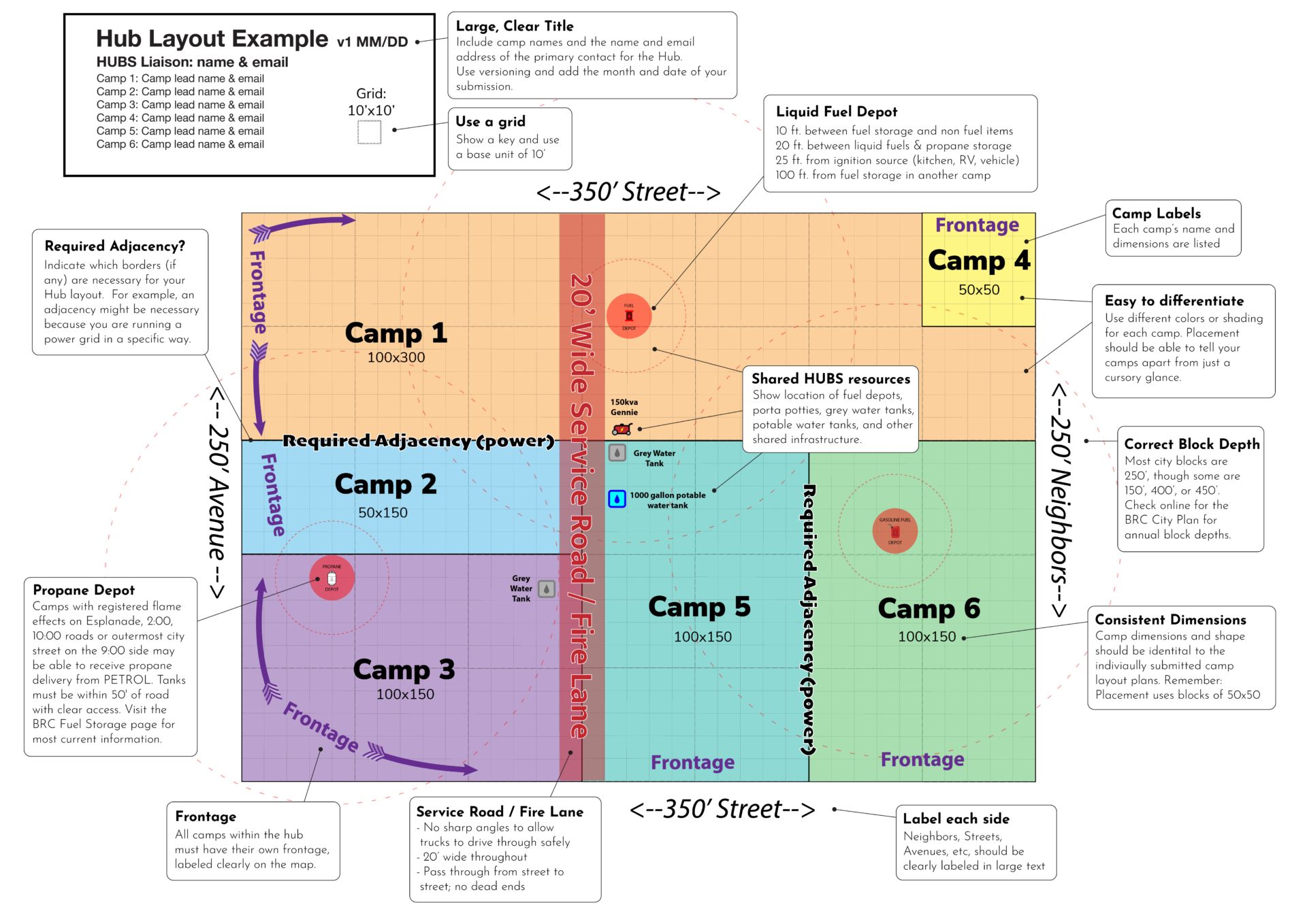HUBS (Humans Uniting for Better Sustainability) is a resource-sharing system first introduced in 2022 to help camps plan and share resources to support Burning Man Project’s goal to handle waste ecologically, be regenerative, and be carbon negative by 2030.
HUBS is built to co-locate camps who have partnered to efficiently share resources such as water, power, tools, and transportation. HUBS applicants will be evaluated to ensure adequate resource sharing. The HUBs process is not a way to request your friends as neighbors. If you mainly want to be next to your friends or to just co-program events, do not apply for HUBS and simply request each other as neighbors in your Placed Camp Questionnaire.
Being a camp in a hub is also not a guarantee of receiving placement. All camps will still go through the same Placement Process, meet Placement Criteria, and be selected upon independent review. Only camps who are selected for placement will be considered for the hub.

TABLE OF CONTENTS
How Can You Find a Partner Camp?
Steps to Form a Hub
HUBS Timeline
Important Things to Consider When Forming a Hub
Resources Shared in HUBS
How Placement Will Map Hub Requests
Hub Layout Requirements
How Can You Find a Partner Camp?
- You may already be friends with other camps or might have befriended some on playa — building on those relationships can lead to the best pairings. If you had a great experience with a previous neighbor and their email address you sharpied on your arm is long washed away, email us at placement@burningman.org and we can help with re-introductions.
- SPARK Classifieds is like Craigslist for Burners. Playa Resources categories can be used to post about sharing resources and services like equipment, fuel, gray water, infrastructure, and medical supplies.
- Burner Network’s Burner Mapping Project, a new nonprofit group dedicated to supporting Black Rock City’s camps, completed a worldwide map showing the hometowns of 2019 BRC camps, searchable by city and state.
- The Camp Listing Archive is searchable by year, by camp name, by hometown, and by keyword. If the camp has submitted a public URL or email address, you can use that to contact the camp.
- Global Regional Directory lists Regional Contacts whose role is to help local Burners connect with each other. There are contacts in almost every continent and many host happy hours where you can meet Burners near you!
Steps to Form a Hub
- Decide which of the camp leads who are filling out a Placed Camp Questionnaire will be the HUBS Liaison for your hub. This person will notify us that they are accepting this role through the Placed Camp Questionnaire.
- Fill out the Placed Camp Questionnaire by the last Thursday in March!
- Lay it out! We need a map of how camps wish to be positioned in relation to each other. The HUBS Liaison won’t be able to complete the questionnaire until they’ve uploaded your hub layout. Read about layouts below for instructions on this.
- We’ll review and follow up with any additional information we may need.
HUBS Timeline
- Last Thursday in March: Placed Camp Questionnaire due for all theme camps, and support camps (art, mutant vehicle, work) that wish to form a hub by 12pm (noon) PT / 3pm ET / 9pm CET
- Support camps in a hub must also complete the Placed Camp Questionnaire by the theme camp deadline rather than April deadline for support camps that are not in a hub.
- May: Placement maps Black Rock City and determines hub locations
- June: Placement notifies camps and hubs of their approximate locations
Important Things to Consider When Forming a Hub
Take care in deciding who you want to form a hub with and make sure it’s for the right reason: to share resources between camps to lower costs, create efficiencies for your camps, or to further the sustainability efforts of our temporary city.
Get to know the camps you’ve gotten along with on playa; ask what their addresses or sectors have been in the past. Some important questions to ask about each other:
- Is where they’ve been placed mesh with where you want to be placed?
- Is your interactivity complementary or will your schedules clash?
- Are you a loud camp and they’re a quiet camp?
- Does your camp have kid-friendly events while the proposed pair camp is an adult-only camp?
You may have camps that you’ve requested to be neighbors with and haven’t been placed near; please remember, there may be one or more reasons that each of your camps have been given the addresses they’ve received.
Resources Shared in HUBS:
- Power (Generator)
- Power (Renewable/Solar)
- Waste/Grey Water Containment and Removal
- Fresh Water
- Shower
- Kitchens/Food
- Transportation (People/Ride share)
- Transportation (Cargo)
- Storage
- Tools/Equipment
- Heavy Equipment
- Sound Equipment
- Medical Supplies
- Fuel
- Shade
- Structures for Public Interactivity
- Performance Stage
- Lighting
- Common Areas
- Access or Fire Lanes
- Interactivity
- Leave No Trace Efforts

How Placement Will Map Hub Requests
A lot of thought and care is taken in looking at the macro-scale of the sector itself and the micro-scale of the neighborhoods on a one-to-two block radius. The Placement team thinks about how camps of different shapes and sizes fit together, interactivity throughout the day and night in each neighborhood, and how it all flows together.
Hubs are one more factor for the Placement team to consider and may influence where your camp is placed in BRC. If your camp is used to being on Esplanade and your united camps don’t warrant the same location, your hub may be placed in a lower profile area of the city. This can also work the other way around — you may prefer being back on H street, but your hub’s combination of camps may warrant a Plaza, for example. Make sure to talk about these possibilities.
Keep in mind that once placement locations are announced, it is very difficult to move camps around. Moving one camp is hard, and moving multiple camps is even more difficult. Please alert Placement ASAP of any changes that occur to your hub (such as if a camp decides to separate or an additional camp wishes to join). We will do our best to accommodate, but may not always be able to.
Hub Layout Requirements
The Placement team needs to understand how the camps within each hub are physically configured. Please submit a map that details the orientation of the camps to each other, indicate the frontage of each camp, and illustrate/label what your camps are sharing that require the configuration (such as a power grid).
We recommend your hub fit as much as you can within a rectangular shape with 4 corners. While we will try to work with your requested shapes, we may need to modify the configuration based on available space. Most BRC blocks have a depth of ~250’. Esplanade to A is ~400’ deep and E to F is ~450’ deep. Average length of full blocks is around 1000’.
Note: This is not your individual camp layout, which has its own requirements and specifications. Please review the Camp Layouts page for more information on how to create a camp layout.
Layout Specs
- The HUBS Liaisons name and email should be at the top left
- List each camp in the hub and include the camp lead and email address
- Include the total dimensions of the hub
- Include the dimensions of each of the borders of the individual camps.
- Indicate camp frontages for each camp.
- Indicate fire and access lanes in your layout. Fire and Service Access Lane Requirements for each camp in your HUB can be referenced above.
- Indicate where adjacency between specific camps is necessary
- The camps should be easy to differentiate, use different colors or shading
- The camps should have consistent dimensions
Fuel Storage and Delivery Requirements (for camp receiving fuel through Burning Man’s Fuel Program)
- Camps Must keep a clear path to generator(s)
- A 10’ perimeter must be maintained between the fuel storage and non-fuel items such as tents, containers, vehicles, etc.
- Fuel storage must be 25 feet away from all possible ignition sources
- No fuel storage within 100 feet from other fuel storage
- A minimum of 20 feet between liquid fuel storage (diesel, gasoline) and propane storage
If your hub plans to receive fuel delivery from the BRC Fuel Program this year (delivery is only available for dyed diesel generators of 30+ gallons per delivery and drums of fuel) please include your generator location on your hub layout. Your generator should be no more than 20 feet away from your frontage street with a straight access for the fuel hose to reach it from the road. If you are approved to have your generator on an access lane or you have a pre-flagged Service Alley, parameters must be at 20’ fire/servicing lane requirements from the access road or Service Alleys in order to be fueled. Fire/servicing lanes must not include any sharp turns or corners, trucks must be able to pass straight through to the street. There must be clear unobstructed access to the generator from either the street or access lane.
File Requirements
-
- We will accept multi-page PDFs with one version of your HUB per page. Each page must meet the layout specs.
- Maximum file size: 10 MB
- Accepted file types: .jpg .jpeg .pjpeg .png .pdf
- Include the day and month and HUBS Liaison’s name or playa name
- Filename must not have spaces, please place underscores (_) between words.
- Limit file name to 20 characters or less.
- The file extension (i.e., .jpg) must be included
- File format example: firstname_lastname_mm.dd.jpg


